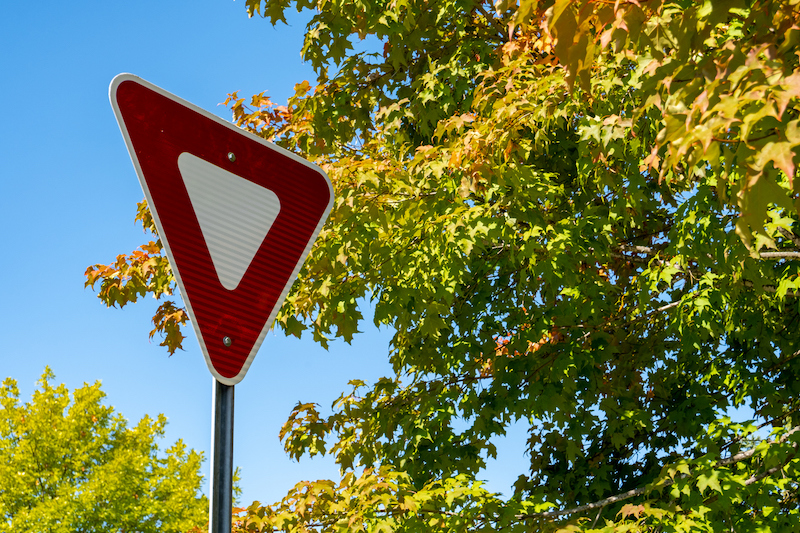Rosenbaum Personal Injury Lawyers | August 4, 2023 | Car Accidents

Like any other state in the country, New York has its own particular set of statutes that govern the ownership and operation of motor vehicles within its jurisdiction.
These statutes, collectively known as the state’s Vehicle and Traffic laws, are sometimes informally referred to as New York’s “rules of the road.” Many of these rules are directly reinforced through clear indications and signals, such as speed limit and “Do Not Enter” signs.
Right-of-way laws are similar: Although there may be signs directing who has the right of way in a given situation, New York’s Vehicle and Traffic laws clearly articulate these particular regulations.
Why It Is Important To Understand NY’s Right-of-Way Laws
There are two reasons why drivers in New York should familiarize themselves with the state’s right-of-way laws. First and foremost, even if these rules are not set forth on signs that are clearly posted, you are expected to be aware of and follow them. You can be ticketed and forced to face fines or other penalties if you are caught disobeying them.
More importantly, though, New York’s right-of-way laws are crucial to motorists’ staying safe on the road. You and your fellow drivers have a legitimate expectation — that other motorists know and will follow these rules. When they do not, they do nothing but increase the likelihood of a car accident that can result in severe injuries or death.
A Summary of New York’s Right-of-Way Rules
Right-of-way laws govern how traffic is to proceed when cars or trucks from two or more opposing directions are converging toward a single point. Intersections, therefore, are perhaps the most common place in which these laws come into play, along with places where two lanes of traffic traveling in the same direction merge into a single lane.
Some of New York’s most significant right-of-way regulations concern the following circumstances:
Entering Intersections
If you are approaching an intersection, but there is traffic already moving through it, you must yield the right of way to that other traffic. You may not proceed through the intersection until the pre-existing traffic has cleared and it is safe for you to proceed.
Turning Left
When turning left, whether you are doing so at an intersection or from a road into a driveway or parking lot, you must yield the right of way to oncoming traffic. The law states that you cannot turn left until all other traffic has passed your location and you can complete your turn safely.
Intersections Where You and Others Arrive At the Same Time
Suppose that you and another driver stop at an intersection at the same time, and now your vehicles are at right angles to each other. Furthermore, suppose that the intersection is only controlled by a stop sign as opposed to a set of street lights. In such a case, you would yield to the other vehicle if that vehicle is to your right.
New York’s Right-of-Way Laws Are Extensive, But Not Always Clear
There are other right-of-way laws beyond these select few, including rules giving pedestrians in the roadway the right of way in certain circumstances, as well as laws requiring you to yield the right of way to emergency vehicles. Some of these are simply matters of common sense, though others may be little-known and confusing.
Whenever a question arises regarding who has the right of way, though, it is advisable that you yield to any other ongoing traffic and proceed carefully along your way.
Contact the New York City Car Accident Law Firm of Rosenbaum Personal Injury Lawyers for Help Today
If you’ve been injured in an accident in Manhattan, NY, and need legal help, contact our car accident lawyers at Rosenbaum Personal Injury Lawyers to schedule a free consultation. We also serve in Brooklyn and the Bronx.
Rosenbaum Personal Injury Lawyers – New York City Office
100 Wall St, 24th Floor
New York, NY 10005
(212) 514-5007
Our firm is located near you. We have an office in NYC
Find us with our GeoCoordinates: 40.7051415,-74.0067386
Rosenbaum Personal Injury Lawyers – Bronx Office
1578 Williamsbridge Rd suite 3b
Bronx, NY 10461
(929) 447-2347
Our firm is located near you. We have an office in the Bronx
Find us with our GeoCoordinates: 40.8468944,-73.8483118
Rosenbaum Personal Injury Lawyers – Brooklyn Office
32 Court St #704
Brooklyn, NY 11201
(718) 550-3601
Our firm is located near you. We have an office in Brooklyn
Find us with our GeoCoordinates: 40.692948,-73.991038
